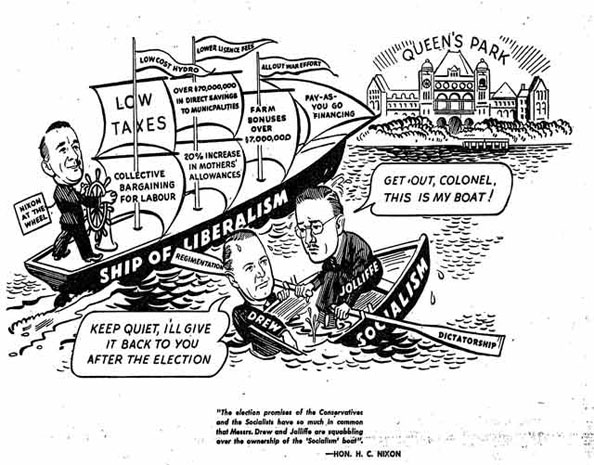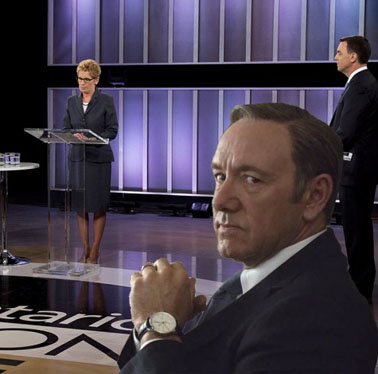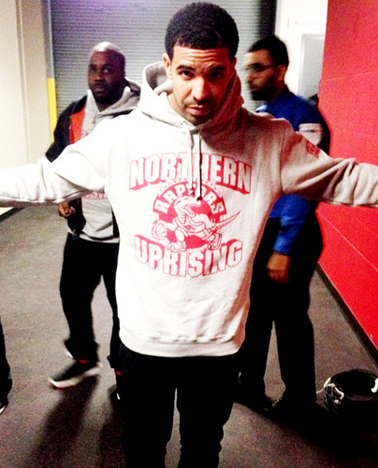Ontario election 2014 : last minute polling notes, and meditations on the low voter turnout syndrome
Jun 11th, 2014 | By Randall White | Category: In Brief
The provincial election of August 4, 1943 was another watershed for Ontario. It was another three-way contest, among Liberal leader Harry Nixon, Conservative leader George Drew, and Ted Jolliffe, leader of the CCF ancestor of today’s New Democrats. And it began the long dynasty of the original “Progressive Conservatives” in the province – starting as a minority government, kept in office until 1945 by the CCF!
The editors tell me this is the last posting on the (first?) Ontario election of 2014 that counterweights will publish before the actual vote tomorrow. So I have one or two housekeeping matters to attend to, before getting into my main subject of declining voter turnout in Ontario (and elsewhere in the free and democratic universe).
To start with, Eric Grenier’s June 10 aggregating and averaging meditations on the polling scene are worth noting : “Ontario race remains tight with days to go … It is coming down to the wire in one of the closest elections this site has covered. The latest polls added to the model all suggest an extremely close race …Â The Liberals are now narrowly in front with 37.3%, or between 36% and 41%, followed by the Progressive Conservatives at 36.5%, or between 35% and 40%. The New Democrats have up-ticked to 19.8%, or between 18% and 21%, while the Greens stand at 5.2%, or between 4% and 7% support.”
 Another intriguing straw in the wind is Andy Radia’s recent piece : “A minority government looming in Ontario as Liberals and PCs are neck and neck.” Among other things, this explains how “the Globe and Mail‘s Adam Radwanski notes that the Tories and the Liberals both ‘appear to genuinely believe they are on track to win minority government …Â Liberals and Progressive Conservatives confirm that their private opinion research showed the same phenomenon as some publicly available polls –Â a shift of support late last week away from Kathleen Wynne’s party, primarily benefiting Tim Hudak’s,’ Radwanski wrote.”
Another intriguing straw in the wind is Andy Radia’s recent piece : “A minority government looming in Ontario as Liberals and PCs are neck and neck.” Among other things, this explains how “the Globe and Mail‘s Adam Radwanski notes that the Tories and the Liberals both ‘appear to genuinely believe they are on track to win minority government …Â Liberals and Progressive Conservatives confirm that their private opinion research showed the same phenomenon as some publicly available polls –Â a shift of support late last week away from Kathleen Wynne’s party, primarily benefiting Tim Hudak’s,’ Radwanski wrote.”
And then, as if to qualify Adam Radwanski’s latest thoughts (like so much else in this mysterious campaign), we have : “Poll: Liberals take lead over Tories …Â Kathleen Wynne’s Liberals lead Tim Hudak’s Progressive Conservatives as Thursday’s election goes down to the wire, a new poll suggests … The Forum Research survey conducted Monday found the Liberals at 42%, the Conservatives at 35% and Andrea Horwath’s New Democrats at 19%. Mike Schreiner’s Greens were at 3% …Â In last week’s poll, the Liberals had 39% to 37% for the Conservatives while the New Democrats were at 17% and the Greens were at 6%.”
Even more in the spirit of the mysterious Northern Uprising election of May and June 2014, an Ipsos Reid poll released late today offered something more or less completely different : “Tories, Liberals and NDP in tight three-way race. This last Ipsos “online poll of 1,191 … has determined that Kathleen Wynne and the Liberals have the support of 33% of decided voters compared to 31% for Tim Hudak and the Tories, 30% for Andrea Horwath and the NDP and 5% for all other parties, including Mike Schreiner and the Greens.”
Finally, Ipsos Reid has been assuming (finding?) that so-called “likely” as opposed to merely “decided” and “eligible” voters will break in favour of the Hudak Conservatives. But in the penultimate “EKOS poll for iPolitics, the Liberals have a substantial lead in likely voters, 41.2% to 33.2% … The NDP only has the support of 17.1% of likely voters.” And all the EKOS data “puts the Liberals near majority territory.” (Which is also the general direction in which the Forum Research poll noted above seems to point.)
So … go figure. Whatever else, it should be very interesting indeed to see what really happens tomorrow night, in the only poll that counts. The mysterious election seems to be remaining mysterious right down to the wire.
(And for my own further final pre-election meditations, on the low voter turnout syndrome, click on “Read the rest of this page” and/or scroll below. The same goes for some absolutely and utterly final polling updates!)
1. What’s going on with voter turnout in Ontario ?
As has been widely noted in the media coverage, voter turnout in the last Ontario general election of 2011 plummeted to a record low of 48.2%. The majority of eligible voters in the province decided not to vote! And according to the public interest group Democracy Watch, this time, in 2014 : “Voter turnout likely to drop to new record low of about 45%.”
On first blush, “a 6% decrease in ballots cast during advance polls” this year compared to 2011 might seem to lend support to the Democracy Watch prediction. There were only seven days of advance polls this year, however, compared to 10 days in 2011. And across the province : “Elections Ontario saw an estimated 25.4% increase in the average volume of voters per day during most recent advance polls than it did in 2011 –Â 80,978 versus 60,379 … ‘I think it’s a good sign,’ Livianna Tossutti, an associate professor of political science at Brock University, said of the average volume of voters who showed up each day.”
I.e. voter turnout may actually increase somewhat on June 12, 2014. Or as Ms Tossutti has also urged : “When you have a close race, you will see turnout increase, that’s my initial guess.” (And by virtually all accounts we do have a close race in Ontario in 2014.)
At the same time again, even if turnout does not increase, and falls as low as 45%, it is worth noting that Ontario is far from the only present-day “free and democratic society” (as our Canadian Constitution Act 1982 puts it) with declining levels of popular interest and participation in politics. See, eg, Jan-Werner Müller’s review of Ruling the Void: The Hollowing of Western Democracy by Peter Mair, in the 22 May 2014 issue of the London Review of Books.
Looking at the history of voter turnout in Ontario provincial elections is nonetheless a troubling exercise. People my age, eg, can remember voting in the general election of 1971 (William G. Davis’s first outing as Progressive Conservative leader). Turnout then was a healthy enough 73.5%. But it would never been so high again. And it has fallen consistently since the provincial election of 1990 – when the New Democrats under Bob Rae formed their first (and as yet only) government at Queen’s Park. (Here are the % turnout numbers since 1971, stacked vertically so to speak, to facilitate quick comparisons :
1971Â Â Â 73.5
1975Â Â Â 67.8
1977Â Â Â 65.6
1981Â Â Â 58.0
1985Â Â Â 61.5
1987Â Â Â 62.7
1990Â Â Â 64.4
1995Â Â Â 63.0
1999Â Â Â 58.3
2003Â Â Â 56.8
2007Â Â Â 52.1
2011Â Â Â 48.2 .)
Even a quick glance at turnout numbers since the creation of the modern province of Ontario in 1867 will confirm that voter turnout has had its ups and downs since then. In the 40 general elections that have taken place since then (not counting the 41st tomorrow), voter turnout has been 70% or more on only nine occasions :
1867 Â Â 73.9
1898Â Â Â 74.4
1902Â Â Â 71.3
1905Â Â Â 70.4
1919Â Â Â 72.6
1934 Â Â 74.1
1937Â Â Â 71.7
1945Â Â Â 72.2
1971Â Â Â 73.5
Similarly, until the 2011 election the 52.1% who turned out in 2007 was the record low since 1867. But turnout was as low as 54.7% in 1923, 56.2% in 1929, 58.4% in 1943, 59.6% in 1959, 58.0% in 1981, 58.3% in 1999, and 56.8% in 2003.
In any case, as with so much else in this mysterious Ontario election, the state of the voter turnout art is another key number to watch out for.
2. Absolutely and utterly final polling updates
Eric Grenier’s final poll aggregation and averaging report came late on the evening of June 11. Broadly, it shows the New Democrats increasing their share of the vote, at the expense of all of the Liberals, Conservatives, and Greens. But this increase is not enough to put them close to the status of contenders for forming a government.
More exactly, Grenier projects : Lib 36.9% of the vote and 49 seats, Conservatives 35.8% of the vote, and 36 seats, NDP 22.2% of the vote and 22 seats. This scenario finally implies another Liberal minority government – and indeed a situation in the Legislative Assembly not much different from what prevailed on dissolution.
Meanwhile, the final polls from four different pollsters all imply potentially rather different scenarios. To start with, the Ipsos decided-voter result of Liberals 33%, Conservatives 31%, and New Democrats 30% has been understandably grasped by NDP strategists as a sliver of hope for a big-surprise result that might even make Andrea Horwath a minority premier. But Ipsos’s own “likely voter” projection of Conservatives 36% , and Liberals and New Democrats 30% each points to Tim Hudak as a minority (or possibly even a majority?) premier.
Somewhat similarly, Abacus is saying : “As voters head to the polls on Thursday, the election is too close to call. While the Liberals lead by three points among eligible voters, the Tories and Liberals are tied among likely voters, with 36% each. The NDP’s gains in our last survey have been sustained although they continue to do well among eligible voters with 26% support. However, among likely voters, NDP support has dropped to 23%. The big wildcard in the election is turnout and the motivation of voters as they decide whether to vote at all. We know that PC voters are more motivated which could make the difference in breaking the tie we report from the survey.”
On a quite different front, the final poll from Forum Research is headed “Liberals to form government in Ontario … Set to win slim majority.” More exactly here : “In a random sampling of public opinion taken by the Forum Poll among 1054 Ontario voters on the night before the provincial election, more than 4-in-10 voters will support the Liberals (41%), compared to just more than a third who will support the PCs (35%), and this has not changed since we last polled (June 9, Liberals – 42%, PCs – 35%). The NDP will take one fifth of the vote (20%), few will vote Green (3%) or for other parties (1%) and these results have not changed since the last poll.” Forum’s final seat projection is Liberals 57 (54 is a bare majority), Conservatives 37, New Democrats 13.
Somewhat similarly again in this case, the final poll from EKOS is headed “An Overview of the Campaign and a Reasoned Guess at the Outcome … WYNNE LIKELY HEADED FOR MAJORITY.” And the detailed analysis here goes : “Wynne has recaptured what was a highly stable, modest lead (37.3 per cent, versus 31.3 for the Progressive Conservatives). The about-to-conclude 41st Ontario general election has been an interesting and closely contested contest. It featured an unusually stark choice between two highly contradictory policy visions …Â Superimposed on this issue was the other master issue of the election; the issue of regime fatigue and high concerns with the ethics and accountability of the veteran Liberal government … In short, Wynne appears headed for a victory. Indeed, with these figures, combined with a six-point lead among likely voters, Wynne is likely headed for a majority.”
Not all of these pollsters can be right, of course, and it will be interesting enough to see just which scenarios stand up to the ultimate wisdom of the people of Ontario (or at least those among them who are actually prepared to vote!).
Perhaps the broadest appeal of what is about to unfold is that all three (if not quite four) of the parties in contention can reasonably hold out some kind of hope for a final result that will look good enough on them. Meanwhile, I can’t stop thinking myself of one of the great Bill Davis’s assorted pearls of folk wisdom about the politics of Canada’s most populous province : “The people of Ontario have never been spoiled by too much perfection in government.”


